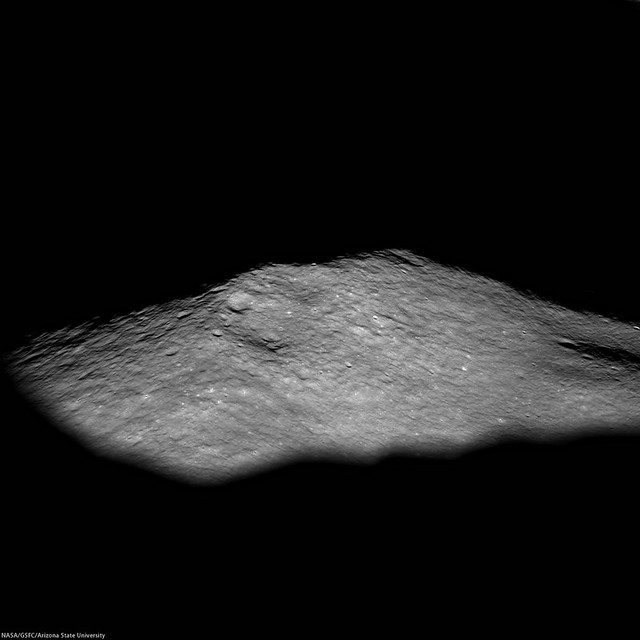 |
| The central peak of Icarus crater rising out of the shadows to greet a new lunar day! Image field of view approximately 10 km (north is at right. LROC NAC oblique mosaic M1124685518LR, LRO orbit 17914, June 1, 2013; spacecraft and camera slew 62.84° from nadir, resolution 3.3 meters per pixel and captured from 106.53 km over 5.58°S, 193.85°E [NASA/GSFC/Arizona State University]. |
H. Meyer
LROC News System
Icarus crater is one of a kind on the Moon; its central peak rises higher than about half its rim. Most central peaks rise only about halfway to the crater rim. Icarus' large, rounded central peak resembles that of Alpetragius on the eastern limb of Mare Nubium.
The disproportionate size of the central peak may be because both Icarus and Alpetragius are close in diameter to the transition between central peaks and peak rings.
Icarus is located just west of Korolev crater on the lunar farside. Like the floor of Korolev, the floor of Icarus is covered with relatively smooth light plains material that can be seen outside the crater as well, filling not only crater floors but also the surface between craters in the highlands (See WAC context image below).
These light plains were deposited during the formation of the Orientale basin, which is located over 1500 km away! The specific mechanism by which the light plains were emplaced is still under investigation, but the plains are likely made of ejecta produced during the formation of the Orientale basin.
See the full size NAC oblique HERE.
Related LROC Posts:
Stopped In Its Tracks
Overprinting Orientale
Crater Mendeleev
LROC News System
Icarus crater is one of a kind on the Moon; its central peak rises higher than about half its rim. Most central peaks rise only about halfway to the crater rim. Icarus' large, rounded central peak resembles that of Alpetragius on the eastern limb of Mare Nubium.
The disproportionate size of the central peak may be because both Icarus and Alpetragius are close in diameter to the transition between central peaks and peak rings.
 |
| A reduced resolution image of the full NAC oblique looking from east to west across Icarus crater (5.348°S, 186.579°E). Notice the gentle slopes of the terraces on the crater wall and many superposed craters that suggest that Icarus is quite old. Icarus is approximately 94 km in diameter . LROC NAC oblique mosaic M1124685518LR [NASA/GSFC/Arizona State University]. |
 |
| A "bonus" oblique assembly of Icarus crater, from a 100 km orbit, looking south, from the Planetary Camera collection from Japan's lunar orbiter SELENE-1 (Kaguya) [JAXA/SELENE]. |
See the full size NAC oblique HERE.
Related LROC Posts:
Stopped In Its Tracks
Overprinting Orientale
Crater Mendeleev



No comments:
Post a Comment